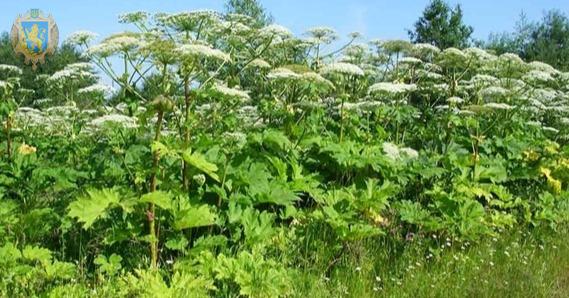A weed, the so-called Sosnovsky’s borscht, has spread throughout the city. It grows on both sides of rivers, roads, forest strips and fields, near summer cottages. The leaves and other parts of the stem of the Sosnovsky borscht can cause dangerous burns. The borscht is a poisonous plant up to two meters high, or even more. When the juice gets on the skin, it turns red after a few hours or even days. With severe burns, the temperature rises, fever begins, ulcers appear. After treatment, dark spots remain in their place.
It is especially dangerous if the mouth or larynx are affected. Most often, children suffer from borschovyk. Borschtovichi bushes can grow in one place for a long time. The poisonous plant has a round and thick root that is difficult to pull out or dig up. It is important to cut off the “cap flower”, trying to stay as far away from the plant as possible. To prevent the juice from getting on your hands, you need to put on rubber gloves. The best result can be obtained if the weeds are treated with roundup when the first rosette of leaves is formed. If you started fighting this plant in the middle of the growing season, it is better to mow it down and treat the remaining leaves and stems with herbicide.
In case of burns with borschtovyk, it is recommended to heavily soap the affected area with household soap and wash it off with a lotion containing alcohol. In no case do not rub the affected area. So you can spread the irritating substance literally all over the body. It is especially important not to touch the face and eyes. In addition, rubbing stimulates blood flow, which means the arrival of new and new substances that support inflammation to the affected area. As with any inflammation, relief will be brought by cold compresses or applying ice to the affected areas.
Cut an aloe leaf, scoop out the pulp with a spoon and apply it to the affected area. Anti-inflammatory and antibacterial properties of aloe make it a very effective remedy. Ready preparations of aloe in the form of gels are suitable for this purpose only if they are made from the natural pulp of the plant.
Pick a few leaves of a common garden weed – plantain, wash them, steam them and, after cooling down a bit, apply poultice to the affected area of the skin. Plantain contains allantoin, a compound with anti-inflammatory and antibacterial properties.
In the washing machine at a moderate temperature, wash the clothes in which you walked through the borscht bushes. This will prevent you from spreading the itchy rash all over your body. Rinse the shoes with water. If you “communicated” with a borschtovy in shoes made of fabric, it should also be washed.
To dry the blisters that have appeared on the skin and soothe the itching, make a vinegar compress. Mix half a cup of table vinegar and one and a half cups of water. Cool the mixture in the refrigerator. When the itching becomes unbearable, moisten a piece of cloth with this solution and apply it to the itchy place.
Wet a regular tea bag (black or green) with water and apply it to the itchy skin. Tannic acid contained in tea leaves will relieve itching and reduce tissue inflammation.
When going for a walk in the forest or a field where poisonous plants can grow, wear pants and a shirt with long sleeves.
Sosnovsky’s borscht
Sosnowsky’s borscht (Heracleum sosnowskyi Manden.) is a perennial plant of the Apiaceae family, up to 3-5 meters in height, stem thickness – up to 10 centimeters, with a 2-5-year development cycle. A flower shoot is formed from its central bud in 3-5, less often in 2-3 years of life. After fruiting, the plant dies completely. Propagated mainly by seeds. The flower is a complex umbrella, white or green-yellow. Its main places of growth are streams, riverbanks, roadsides, and degraded pastures. The plant is rich in phytoactive compounds, so even a one-time touch of the hogweed leads to burns. After 1-2 days, the damaged surface of the body reaches several centimeters, it is difficult to heal, it aggravates the appearance of other skin diseases. Since borscht is a dangerous species, it is necessary to systematically carry out measures to prevent its spread: grazing – young leaves of the plant are eaten by sheep and cows; systematic mowing; cutting thick roots at a depth of 8-12 centimeters, which ensures the destruction of the plant.
The birthplace of Sosnovsky borscht is the Caucasus. It was brought to Ukraine after the Second World War as one of the silage crops that produced as much green mass per hectare as any of the traditional crops. Sosnovsky’s borage tree is also an excellent honey bearer. But it turned out that it has a toxic sap that causes severe burns. It could only be fed to animals as silage – after that the poison decomposed. But all the same, his milk turned bitter. So we had to abandon its breeding. But it was too late. Sosnovsky’s borscht felt great even without special care. The plant went wild easily and was sown by seeds. And now its poisonous thickets have become a common phenomenon in Ukraine.
Stems, leaves and flowers of borscht contain furanocoumarins. These substances sharply increase the sensitivity of the human body to ultraviolet rays

